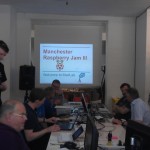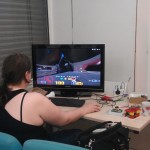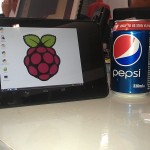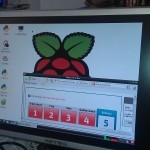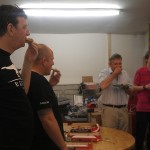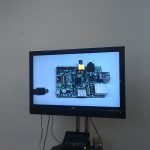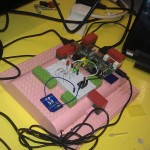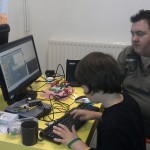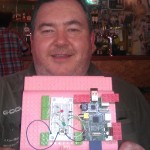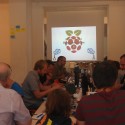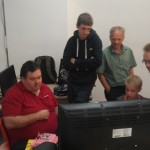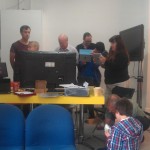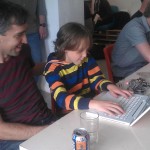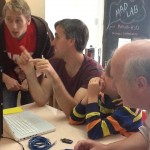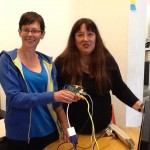I’ve now hosted four Raspberry Jams in Manchester. I posted about the first and second, here’s a summary of what went on at III & IV.
The August Manchester Raspberry Jam kicked off when Kat opened up the Madlab and I gave an opening talk about what had been going on in the news in the Raspberry Pi community, featuring announcements like Raspbian and the Gertboard, and showed examples of what people have been doing with their Pis – including Freaky Clown ruinning Metasploit (a pen testing tool) to the Pi and my personal favourite, Pi in the Sky – the first Raspberry Pi to visit near space. I then got people to write down what they wanted to learn, or what they needed help with, and then what they would be able to help others with, and tried to pair or group people together to work on things.
Kat and Alex got straight on with playing Quake on the big TV, which was pretty cool. Meanwhile visiting newcomer Simon – who was shocked when the taxi driver who shuttled him from the station said he’d never heard of the supposedly world famous Madlab – got out his lego-built Pi/breadboard stand and demonstrated his Scratch/Python/GPIO hybrid project which involved a program built in Scratch which would run through the traffic lights sequence on screen when the space bar was pressed, and also feed the same sequence through to the LEDs on his breadboard. Amazing stuff – if you’re interested in this sort of thing drop him a line on twitter, or take a look at the questions he’s posted to the Raspberry Pi forums to see if you can help.
We also had Paul helping his daughter built a game in Scratch, we saw a Motorola Atrix dock powered by the Pi, we even VNC’d in to a Pi using an Android app on my mobile phone and then from my Nexus 7 tablet! Around 5pm once people had helped my carry my 3 monitors, TV, laptop, netbook and bag full of cables back to my flat, we headed to the pub where we stayed for several hours, and where Simon kept his pink lego Pi kit out on the table. During this time we witnessed HacMan move in to their new hackspace premises just a couple of doors down from Madlab. The phrase “How many geeks does it take to network a hackspace?” was brought up and probably tweeted, as we watched them run a patch cable across the outside wall from Madlab over the café next door. The following day I got my Pi out at home (I never get to play at the Jam – I just end up running around making sure everything’s running smoothly, and in any case all my kit gets handed out and all the screens tend to be in use) and installed OpenElec on a spare SD Card (keeping Raspbian on another), which runs XBMC – a fantastic media centre which I easily managed to use to stream high definition video over the local network from my NAS. I tested it out with X-Men: First Class (720p) which played no problem – looks great on monitor or big TV! I’ve since installed the XBMC Android app on my phone and tablet and I can select something to watch on either device and tell it to play on the TV, then use as a remote control. The future is here.
A month later and we’re back in Madlab for Manchester Raspberry Jam IV – again I begin with a recap of the news: Revision 2.0, Made In the UK and Make Your Own PiOS, and move on to skill share pairing! As usual we get a couple of people who need help setting up their SD card so I volunteered to show them get them up and running, and everybody else just picks something and starts hacking! Simon fires up his pink lego kit again (and eventually ends up blowing it up somehow…), and a newcomer called Ian started work on a project which would allow the Pi to work as Time Machine to back up his Mac!
Later on in the morning a 10 year old kid came up to me and asked if I could teach him some Python (I’d put that up as a sharable skill on the wall) – I said I’d love to, and asked what he wanted to learn, and he said anything to get him started. His Dad sat next to us an observed, saying it reminded him of learning BASIC when he was at school. I started with printing a string, then storing a string in a variable, printing it from its stored value, then storing integers. We then looked at the difference between assignment (x = 1) and comparison (x == 1), and the first idea that came to mind for implementing some of this in a program was checking an entered PIN number against a set value. While showing him the syntax of things like if statements, I let the kid type away, letting him make mistakes if I thought he would learn from the error messages, sometimes asking him what he thought it would do (he would often spot a flaw immediately), sometimes just reminding him to go on to a new line or whatever. But he was doing great. Whenever we completed adding a new feature, I’d ask him what we could do next, so at this point he’d say, “Why don’t we give them 3 chances to get the PIN right?” and we’d look at how to implement that. We’d start by copying the code that asked for the PIN the first time, and sticking it in the ‘else’, so the user would be prompted a second time if (and only if) they got it wrong the first time.
Once we had that working, I introduced the while loop, and explained a simple use case whereby it would count the number of attempts made, and keep running over the same code in the loop until the number of attempts reached 3. Then while adding feedback “Your card is locked” if they were incorrect 3 times, I noted that we could make the number of tries a variable, so that we could change it once at the top and not everywhere in the code. He got that. Then we made it tell you how many attempts you had remaining, by subtracting the number of attempts from the number of attempts allowed. And then he said he thought if he learned any more he might forget what I’d taught him, so he wanted to stop and practise that at home. I emailed the file to his Dad and suggested he might want to try adding something that calculates the balance if they withdrew money.
We finished with a short presentation from a young lad called Barney, who had built a Morse code device with his Dad – you type in a word on the keyboard and the LED on the breadboard flashed according to the Morse codes for the letters in that word. Brilliant! Then we cleared up (and hauled the vast array of monitors to my flat again) and went on to the pub. Everyone always has great fun at the Jams, and everyone’s got something different they want to get out of it. Some just come and take notes and listen to people, some bring their kids to get them excited about computers, some bring crazy contraptions they hope to get working on the Pi with the support of the group, some – like me – just like being there! It’s a great atmosphere and it’s fantastic to see kids and adults playing away, learning and having fun! I don’t generally get much chance to do much myself, but it’s always nice to pass on some python knowledge and help out where possible – and to witness amazing things happening all around me! The Pi is a wonder and we all thank the foundation for all their work in getting it to where it is – and look forward to see where it goes next! Thanks again also to Madlab for hosting the events. I really don’t know how we’d do this if the space wasn’t available.
